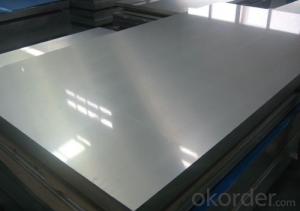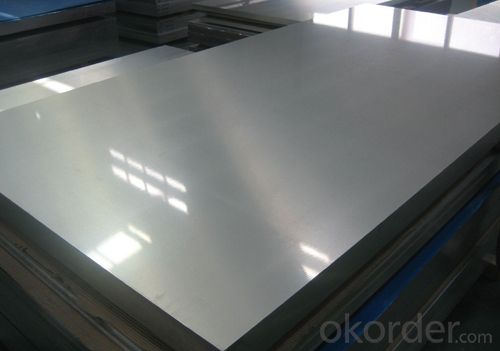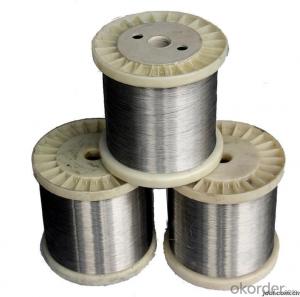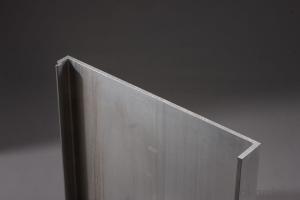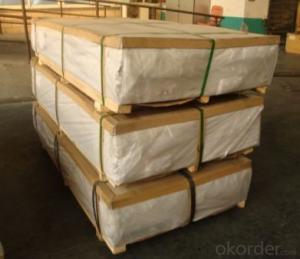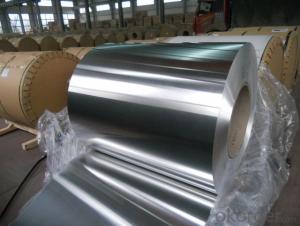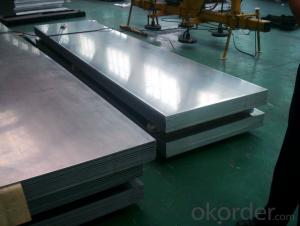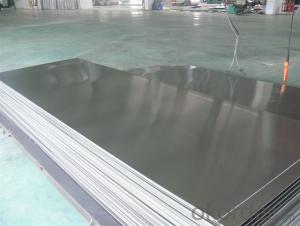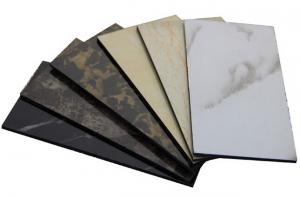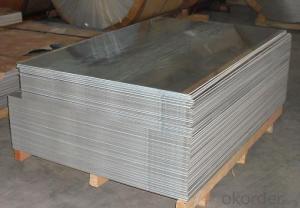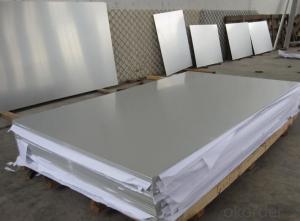Brushed Aluminum Sheets Laminate for Finished Aluminium Panels Wall Decoration
- Loading Port:
- Shanghai
- Payment Terms:
- TT OR LC
- Min Order Qty:
- 5 m.t.
- Supply Capability:
- 60000 m.t./month
OKorder Service Pledge
OKorder Financial Service
You Might Also Like
Specification
Description
| Finished Aluminium Panels Used For Wall Decoration | |||||
Alloy No. | Thickness (mm) | Width (mm) | Length (mm) | Temper | |
A1050,A1060, A1070, A1100 | 0.2-100 | 20-2200 | 20-8000 | O,H12,H22,H14,H16,H18, H24,H26,etc | |
3A21, A3003, A3105, A3004 | 0.2-100 | 20-2200 | 20-8000 | O,H14,H18,H24,etc | |
A5052, A5005, A5083, A5754 | 0.2-100 | 20-2200 | 20-8000 | O,H18,H24,H32,H34,H111,H112 ,etc | |
A6061, A6082, A6063 | 0.2-200 | 20-2200 | 20-8000 | T4,T6, T651,etc | |
A8011 | 0.2-100 | 20-2200 | 20-8000 | O,H12,H22,H14,H16,H18,H24,H26, etc | |
Packing: Export wooden pallets. The bundle weight not exceed 2MT. Loading: by 1x20GP, 1X20GP can load about 25MT. | |||||
Standards: ASTM-B209. EN573-1, GB/T3880.1-2006 | |||||
Quality of material: totally free from defects like white rust, oil patches, roll marks, edge damage, camber, dents, holes, break lines, scratches and free from coil set. | |||||
Application : Mainly used insigns, billboards, building exterior decoration, bus body, high-rise buildings and factories wall decoration, kitchen sink, lamp, fan leaves, with pieces of electronic, chemical equipment, sheet metal processing parts, deep drawing or spinning hollowware, welding parts, heat exchangers, bell surface and disk, plate, kitchenware, decorations, reflective devices, ect | |||||
MOQ | 5 tons | ||||
Payment term | T/T,L/C | ||||
Delivery Time | 15-60 days after 30% T/T payment or receiving L/C copy | ||||
Kind attention: Specifications can be customized as the customer’s requirements. | |||||
PVDF and PE coated aluminium coils/sheets:
PVDF color pre coated aluminum coils/ sheets:
It is well known that fluorocarbon lacquer coating (PVDF coating) owes the best acid resistant/alkali and temperature tolerant capabilities of all painting materials. Being the best quality of precoated aluminum, PVDF coated coils are especially suitable for outdoor roofing walls and ceiling manufacturing.
Polyester (PE) color pre coated aluminum coils/ sheets :
Using high-grade polyester lacquer coating material, the finished coated coils are with delicate color uniform texture, color and diverse. It is the most popular and most common used materials in decorative usage. The PE coated aluminum are widely used in ACP( aluminum composite panel ) production and indoor ceiling usage.


Production facilities and processing range
Equipments | Quantity | Thickness range | Width range | Length range | Max loading weight |
Continuous casting rolling mill | 23 | 6.0-10.0mm | 1000-2000mm | ------------- | 15000kgs |
Cold rolling mill | 2 | 0.1-6.0mm | 900-1700mm | ------------- | 12000kgs |
High accuracy cold rolling line | 1 | 0.1-1.0mm | 650-1420mm | ------------- | OD 2000mm |
Annealer | 14x40T | ------------- | -------------- | ------------- | ------------- |
Coating line | 3 | 0.15-1.5mm | 600-1600mm | ------------- | 5000kgs |
Embossing line | 1 | 0.2-1.2mm | 350-1300mm | ------------- | 8500kgs |
Straightening line | 1 | 0.1-2.0mm | 600-1700mm | ------------- | 10000kgs |
Slitting line | 1 | 0.2-3.0mm | 21-1595mm | ------------- | 10000kgs |
Wave shearing line | 1 | 0.13-0.5mm | 550-1230mm | ------------- | 10000kgs |
Shearing line | 3 | 0.125-4.0mm | Max 1700mm | ------------- | 10000kgs |
FAQ
Q: Can you provide free samples?
A: Yes, free samples will be sent to you on freight at destination.
Q: Can I get your latest catalogue?
A: Yes, it will be sent to you in no time.
Q: What are your payment terms?
A: We accept L/C, D/A, D/P, T/T, West Union, etc
Q: Can you provide free samples?
A: Yes, free samples will be sent to you on freight at destination.
Q: Can I get your latest catalogue?
A: Yes, it will be sent to you in no time.
Q: What is the MOQ?
A: 5 tons.
Q: What are your payment terms?
A: We accept L/C, D/A, D/P, T/T, West Union, etc
- Q: Can the aluminum sheets be used for manufacturing light reflectors?
- Yes, aluminum sheets can be used for manufacturing light reflectors. Aluminum is highly reflective and has excellent light reflecting properties, making it a popular choice for manufacturing light reflectors in various industries.
- Q: Are aluminum sheets suitable for laser cutting?
- Yes, aluminum sheets are suitable for laser cutting. Aluminum is a commonly used material in laser cutting due to its excellent reflective properties, high thermal conductivity, and low melting point. These characteristics make it an ideal material to be cut by a laser beam. Laser cutting provides precise and clean cuts on aluminum sheets, allowing for intricate designs and complex shapes to be easily achieved. Additionally, laser cutting of aluminum sheets is a fast and efficient process, offering high productivity and cost-effectiveness.
- Q: Explain the various types of coatings that can be applied to aluminum sheets.
- <p>Aluminum sheets can be coated with several options to enhance their appearance, durability, and functionality. These include: 1) Anodizing, which creates a protective oxide layer, 2) Powder coating, offering a wide range of colors and textures, 3) Liquid painting, for a smooth, painted finish, 4) Laminating, which bonds a protective film to the surface, 5) Electrolytic coloring, resulting in a variety of colors, 6) PVD (Physical Vapor Deposition), for a high-quality, durable finish, and 7) Thermal spraying, applying a coating to improve wear resistance. Each method serves different purposes and has its advantages and limitations.</p>
- Q: aluminum is 2.82x10^-8 ohm-m
- Aluminum with the same resistance as 50 meters of copper. (Resistance) = (Resistivity)(Length/Area) So if the resistivity changes by (2.82/1.72), then the length changes by (1.72/2.82). So the length of aluminum would be 50m(1.72/2.82) Length of aluminum would be 30.5 meters
- Q: Can aluminum sheets be recycled?
- Yes, aluminum sheets can be recycled. Aluminum is one of the most commonly recycled materials in the world because it can be recycled indefinitely without losing its quality. Recycling aluminum sheets involves melting them down to their original state and then shaping them into new sheets or other aluminum products. This process requires significantly less energy compared to producing aluminum from raw materials, making recycling aluminum sheets an environmentally sustainable option.
- Q: Where does China make aluminum plate?
- In many parts of the country have aluminum factory, the old state-owned enterprises have 101, SWA aluminum plant, located in the southwest, northeast china. The emerging aluminum processing base in Henan, due to resource advantages, the largest aluminum factory, the price is relatively low.
- Q: Can aluminum sheets be used for honeycomb panels?
- Yes, aluminum sheets can be used for honeycomb panels. The lightweight yet sturdy nature of aluminum makes it a popular choice for constructing honeycomb panels, which are commonly used in aerospace, automotive, and construction industries for their strength-to-weight ratio and structural integrity.
- Q: Can the aluminum sheets be used for printing applications?
- Aluminum sheets are indeed suitable for printing applications. Thanks to their smooth and flat surface, aluminum is an excellent choice for printing graphics, images, and text. Various printing methods, including offset printing, screen printing, and digital printing, can be effortlessly employed on these sheets. When opting for aluminum sheets for printing, one can expect durability, resistance against fading and weathering, as well as a polished and sophisticated look. Industries such as advertising, automotive, aerospace, and packaging frequently utilize aluminum sheets for signage, labels, nameplates, and decorative purposes.
- Q: I am engaged in line cutting, because the cut aluminum plate conductive block wear more fierce, molybdenum wire is often broken card, I do not know that heroes have unique skills, say, we share. Thanks.
- The contact position between the conductive block and the electrode wire is often changed
- Q: Are aluminum sheets suitable for chemical storage tanks?
- Depending on the specific requirements of the chemical being stored, aluminum sheets may be a suitable option for chemical storage tanks. Aluminum is renowned for its exceptional resistance to corrosion, making it well-suited for the storage of numerous chemicals. It develops a protective oxide layer that effectively prevents further corrosion, even in harsh environments. Nevertheless, it is vital to take into account the compatibility between the chemical and aluminum. Some chemicals, such as strong acids or bases, can react with aluminum, leading to corrosion or other undesirable reactions. In such instances, alternative materials like stainless steel or fiberglass-reinforced plastic (FRP) might be more appropriate. Furthermore, careful consideration should be given to the thickness and grade of the aluminum sheets, depending on the specific chemical being stored and the intended use of the tank. For highly corrosive or hazardous chemicals, thicker sheets may be necessary, while thinner sheets may suffice for less aggressive substances. In conclusion, aluminum sheets can be a viable choice for chemical storage tanks, provided that careful evaluation of chemical compatibility is conducted and the appropriate thickness and grade of aluminum are selected to ensure safe and reliable storage.
Send your message to us
Brushed Aluminum Sheets Laminate for Finished Aluminium Panels Wall Decoration
- Loading Port:
- Shanghai
- Payment Terms:
- TT OR LC
- Min Order Qty:
- 5 m.t.
- Supply Capability:
- 60000 m.t./month
OKorder Service Pledge
OKorder Financial Service
Similar products
Hot products
Hot Searches
Related keywords
